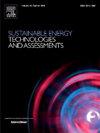Two stage voltage coordination optimization of substation − feeder area considering demand response
IF 7
2区 工程技术
Q1 ENERGY & FUELS
Sustainable Energy Technologies and Assessments
Pub Date : 2025-02-13
DOI:10.1016/j.seta.2025.104232
引用次数: 0
Abstract
A two-stage substation-feeder voltage coordination optimization strategy that incorporates demand response (DR) is proposed to address issues of reverse power flow and voltage violations in distribution networks caused by high penetration rates of distributed generation (DG). Firstly, in the first stage, focusing on voltage stability and the economics of voltage regulation equipment at the substation area, day-ahead centralized optimal scheduling of discrete equipment switching plans is performed to enhance the low-voltage (LV) side bus voltage. In the second stage, building on the first stage’s regulation scheme, the voltage quality at each feeder node is further improved through the coordinated optimal scheduling of DG, DR, energy storage systems (ESS), and reactive power regulation equipment. Subsequently, voltage optimization models for both the substation and feeder areas are constructed. The demand response is precisely modeled at the feeder area, formulated as a mixed-integer second-order conic programming problem, and solved using CPLEX. Finally, simulation results on the IEEE 33 node and IEEE 69 node system demonstrate that the proposed method reduces the number of discrete equipment actions, significantly improves voltage quality, and enhances the economy and security of distribution network operations.
考虑需求响应的变电站-馈线区域两级电压协调优化
针对分布式发电高渗透率引起的配电网反向潮流和电压违规问题,提出了一种考虑需求响应的两级变电站馈线电压协调优化策略。首先,从变电站区域电压稳定性和稳压设备经济性出发,对离散设备切换方案进行日前集中优化调度,提高低压侧母线电压;第二阶段,在第一阶段调节方案的基础上,通过DG、DR、ESS、无功调节设备的协调优化调度,进一步改善各馈线节点电压质量。在此基础上,建立了变电站和馈线区域的电压优化模型。对馈线区域的需求响应进行了精确建模,将其表述为一个混合整数二阶二次规划问题,并使用CPLEX进行求解。最后,在IEEE 33节点和IEEE 69节点系统上的仿真结果表明,该方法减少了离散设备动作的数量,显著改善了电压质量,提高了配电网运行的经济性和安全性。
本文章由计算机程序翻译,如有差异,请以英文原文为准。
求助全文
约1分钟内获得全文
求助全文
来源期刊

Sustainable Energy Technologies and Assessments
Energy-Renewable Energy, Sustainability and the Environment
CiteScore
12.70
自引率
12.50%
发文量
1091
期刊介绍:
Encouraging a transition to a sustainable energy future is imperative for our world. Technologies that enable this shift in various sectors like transportation, heating, and power systems are of utmost importance. Sustainable Energy Technologies and Assessments welcomes papers focusing on a range of aspects and levels of technological advancements in energy generation and utilization. The aim is to reduce the negative environmental impact associated with energy production and consumption, spanning from laboratory experiments to real-world applications in the commercial sector.
 求助内容:
求助内容: 应助结果提醒方式:
应助结果提醒方式:


